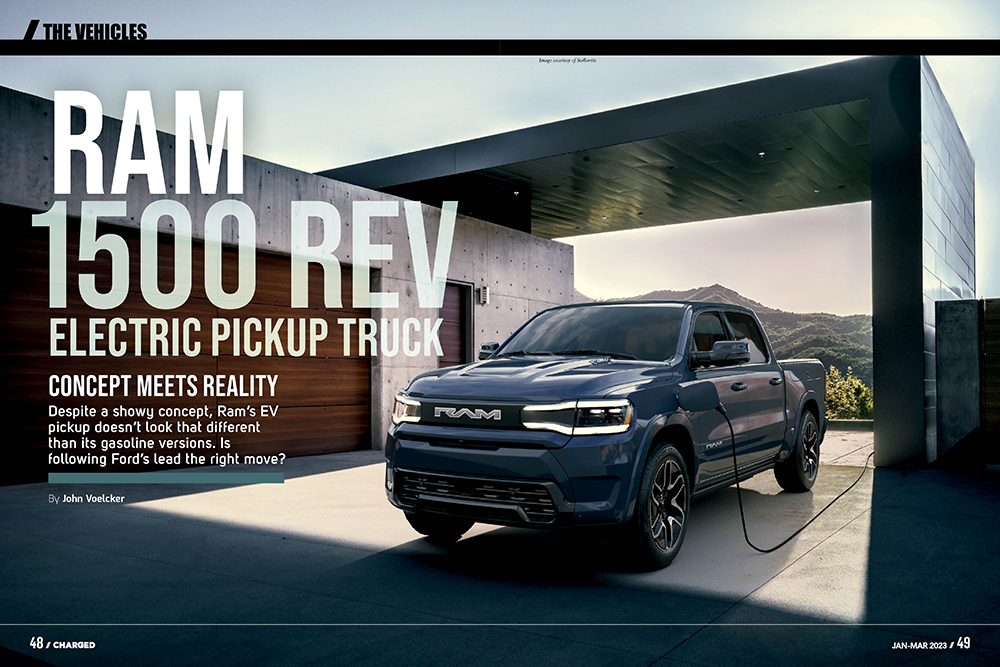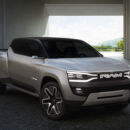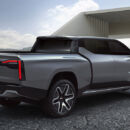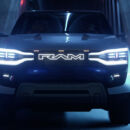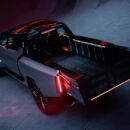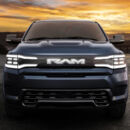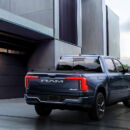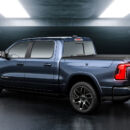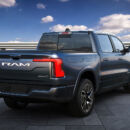Despite a showy concept, Ram’s EV pickup doesn’t look that different than its gasoline versions. Is following Ford’s lead the right move?
It was clear that the striking Ram 1500 REVolution Concept, unveiled at January’s Consumer Electronics Show (CES) in Las Vegas, foreshadowed a production electric Ram 1500 within the next couple of years. Ram is the last of the three Detroit makers to reveal a battery-electric full-size pickup, and the concept stole the show with many tantalizing features. These ranged from a lengthwise pass-through tunnel running bumper to bumper, for long lumber, to a mid-gate that allows the back of the cab to be used as an extension of the bed.
Surprisingly, the production version of the electric Ram 1500—due in Q4 of 2024—didn’t debut at February’s Chicago Auto Show. Instead, it surfaced days later in a cheeky Super Bowl ad addressing “Premature Electrification,” and hinting that the Ram 1500 REV would be the right treatment for that ailment.
Even truck fans might be hard-pressed to tell from the side that it isn’t just another trim variation on the gasoline Ram 1500.
Disappointment or smart tactic?
When the chuckles died down, the striking concept truck was revealed as just that: a concept. The production Ram EV pickup will be considerably more conventional on the outside—with, of course, entirely new underpinnings. Aside from a blanking plate over the grille and different headlights, taillights and wheels, even truck fans might be hard-pressed to tell from the side that it isn’t just another trim variation on the gasoline Ram 1500.
That came as a disappointment to some critics. It’s “not the game changer we expected,” said Car and Driver. “No design revolution,” sniffed Green Car Reports.
But in that respect, Ram has followed the lead of the Ford F-150 Lightning. Both use instantly recognizable cabs, pickup beds and profiles of their makers’ latest combustion-powered pickup trucks. That puts Ram and Ford in contrast to the approach taken by General Motors.
Ram 1500 REVolution Concept (above) versus RAM 1500 REV Production Version (below).
That company’s upcoming Chevrolet Silverado EV and GMC Sierra EV pickups unite the cabin and bed in a single structure, with a mid-gate that allows use of the passenger cabin for extra storage ahead of the bed. It’s reminiscent of nothing so much as the 2002-2013 Chevy Avalanche four-door unibody pickup.
Pickup aficionados will debate the merits of the two approaches for years to come. GM says it expects its EV lineup to be “additive” rather than “substitutive,” meaning it believes it will gain new customers who’ve not previously driven its trucks. Ford and Ram, conversely, appear to be targeting and reassuring existing customers, by highlighting the similarities of their electric trucks to their combustion-engine siblings.
Giving truck buyers what they want
Ram clearly feels that pickup buyers want trucks that appear very similar to its current models. The looks are deceptive: An entirely new architecture, STLA Frame, sits beneath that familiar body. It’s intended solely for body-on-frame EV models, a genre largely confined to North America.
The looks are deceptive: An entirely new architecture, STLA Frame, sits beneath that familiar body. It’s intended solely for body-on-frame EV models, a genre largely confined to North America.
Ram also confirmed that it will offer a range-extender version with a gasoline engine. In a late February media roundtable in New York City, Stellantis CEO Carlos Tavares clarified that this truly meant a way to extend the range of a battery-electric pickup truck—not just a Jeep-style plug-in hybrid with perhaps 40 miles of electric range.
Few technical specs are available to date—unsurprising, considering that the Ram 1500 REV won’t go into production for more than a year. Interested buyers can provide a refundable $100 deposit on a web site called RamREV.com, where further information is promised in due course.
There’s little question that the former Fiat Chrysler has lagged on electrification. Through the 2010s, it sold only the California-only Fiat 500e, while then-CEO Sergio Marchionne regularly highlighted the company’s loss of $14,000 per vehicle. It launched a plug-in hybrid version of its Chrysler Pacifica minivan in 2017, and followed that with the Jeep Wrangler 4xe and more Jeep PHEVs to come.
Few technical specs are available to date—unsurprising, considering that the Ram 1500 REV won’t go into production for more than a year.
GM has sold cars with plugs in volume since 2011. It now has bold plans for a dozen or more electric models built on its Ultium architecture. Those include the Chevy Silverado EV full-size pickup that debuted at last year’s CES, which is supposed to enter production this year—fleet models first, then consumer versions.
As for Ford, after it fired a CEO for lack of progress on electric vehicles, it launched the surprising and successful Mustang Mach-E electric SUV, the E-Transit commercial delivery van, and the wildly popular F-150 Lightning electric full-size pickup truck. All are now in production.
Stellantis steps up—Jeep, Ram lead in US
CEO Tavares said his company will have announced eight battery-electric vehicles for North America by the end of this year. The first three to hit the roads will be an electric version of the Ram ProMaster commercial van, followed by the entirely redesigned Fiat 500e and the Maserati Grecale Folgore, all by the end of 2023. Following that next year will be two Jeep EVs and the production Ram 1500 REV, plus two more.
CEO Tavares said his company will have announced eight battery-electric vehicles for North America by the end of this year.
Those are a subset of the global portfolio of EVs being launched by Stellantis—the company had 23 separate models at the end of 2022, expects 32 by the end of this year, and 47 by the end of 2024. Many of those are small European models from brands not sold in North America, including Citroën, Peugeot and Opel/Vauxhall.
Jeep’s first three all-electric models were revealed last September. The subcompact Avenger went into production in October and is now on sale in Europe, where it was named 2023 European Car of the Year—a surprise honor. But it’s an entire size class smaller than the smallest Jeep sold in the US, the Renegade, so we won’t see it in North America. However, both the sleek, luxurious Wagoneer S and the upright, square, off-roading Recon will be sold around the world. Built in North America, those two will go on sale in 2024.
Jeep went global—will Ram?
Asked about the practicalities of devoting scarce capital to a new EV that could really only be sold in North America, CEO Tavares told Charged, “We see strong demand for what Ram has to offer. People all over the world are buying the US lifestyle, the power. We will have news on that front soon.”
We see strong demand for what Ram has to offer. People all over the world are buying the US lifestyle, the power. We will have news on that front soon.
Does that mean that the Ram 1500 REV itself will be sold globally, or that the Ram brand will expand outside its current North American market? Tavares suggested that “Ram has some opportunities globally,” as Jeep did 10 years earlier, but that “the whole world is not moving at the same pace on EVs” as Europe and North America.
If we had to guess, we’d suggest that means you may see Ram pickups sold in Europe and elsewhere—but they’re likely to be smaller than the Ram 1500 REV, and perhaps not electric.
This article appeared in Issue 63: Jan-Mar 2023 – Subscribe now.




